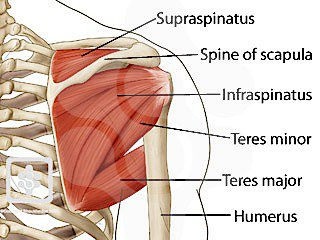Shoulders: "Complex" to treat? They don't need to be!

Why complicate an already complicated area of the body? The shoulder or Shoulder Complex to give it it's proper name, by definition is complicated! It comprises of 4 joints alone. Each joint held together with several ligaments and each joint powered by several muscles. Some of which can be seen in the image on the left. Until recently, in order to ascertain what was going wrong inside a shoulder with someone with shoulder pain, we used to perform a series of provocation tests to ascertain the structure at fault. These tests would provide us with a positive. So we would try and target the specific structure at fault and rehabilitate that. Results were variable, newly qualified physiotherapists dreaded assessing shoulders. Looking back, it is hardly unsurprising.
What we now know is that the provocation tests were largely giving us false positives! Our patients were telling us their shoulder hurt and all we did was aggravate it and everything we conducted thereafter was painful. Our patients walked out of clinics in more pain than when they arrived! Is it surprising that they most likely didn't do any rehabilitation for fear it would make it just as painful as the assessment? Largely thanks to two highly regarded physios, Jo Gibson and Chris Littlewood (A Huddersfield physio too!), who conducted a host of studies and have demonstrated a far more streamlined approach to assessing a shoulder problem. Whilst they disagree on some aspects, they largely agree.
The first thing they agree on is stop performing the provocation tests! They only make the patient more painful and therefore less likely to be compliant with you. It also takes a lot of stress from the clinician too! Secondly, they both agree that shoulder falls into 3 categories: Is the shoulder stiff? Is the shoulder painful and stiff? Finally, is the shoulder painful only? If you are able to establish this, then clinical reasoning can help you categorise pathologies: Stiff: Most likely: Frozen Shoulder
Stiff and Pain: Most likely: Arthritic changes
Painful only: Most likely: Rotator Cuff* weakness
The Rotator Cuff

*The group of muscles that stabilise the shoulder and allow seamless movement of the arm. It is here where Gibson and Littlewood disagree slightly when identifying a painful only shoulder. Gibson would state this was a shoulder impingement and give a series of exercises to target the various aspect of the rotator cuff group of muscles and allow a period of avoid aggravating factors. Littlewood has conducted numerous studies and suggests that it is impossible to ascertain which structure is weakened or "faulty" with a painful shoulder and therefore you cannot target this with a series of targeted exercises. Littlewood suggests we are looking at a weakened rotator cuff group of muscles or simply: muscle weakness.
The most common reason for shoulder pain is pain limited only. I have only ever diagnosed a true frozen shoulder ONCE! I have hardly, if ever seen an arthritic shoulder. I have been fortunate enough to be on a training seminar with Chris Littlewood and have seen his work in action firsthand. And I have to say, since I have used his approach in my clinical setting, he has converted the most dreaded joint in the body to assess and treat, to the quickest and easiest to treat. And I do have to add, that I was getting mixed results under the Gibson approach, whereas I seem to be getting more of an efficacy with the Littlewood approach! So, if shoulders have been so difficult to assess, why not offer a scan?

As with provocation tests, imagery can give us a false positive! I cannot deny that imagery will identify an abnormality lying beneath the skin, yet it may not be the reason for the patient's pain. Take the image, left. 3000 males were given an ultrasound who had no shoulder problems or pain. The results are astonishing! Over 75% of people had an inflamed bursa, yet pain free! Almost two thirds had arthritic changes in their AC Joint (where your clavicle or collar bone attaches to the acromion or shoulder bone), yet pain free!
Almost as many people had a tendinopathy in one of their tendons that form the rotator cuff, yet still lived pain free!
And what is most surprising, almost a quarter had a tear in their rotator cuff, yet lived pain free! What Chris Littlewood had researched and established is that as we age, the body will naturally form tears in the rotator cuff to maintain the shoulder movement that we take for granted! Therefore, if we offered imagery and established a tear or arthritis and performed corrective surgery, would pain be eradicated? Or would movement be suddenly restricted and still have pain? As I have said before: Imagery does bot always equal pain!
I have enjoyed treating a host of clients with shoulder pain for some time now. Largely thanks to the work of Gibson and Littlewood who through their hard work have made this complex, simple!



















